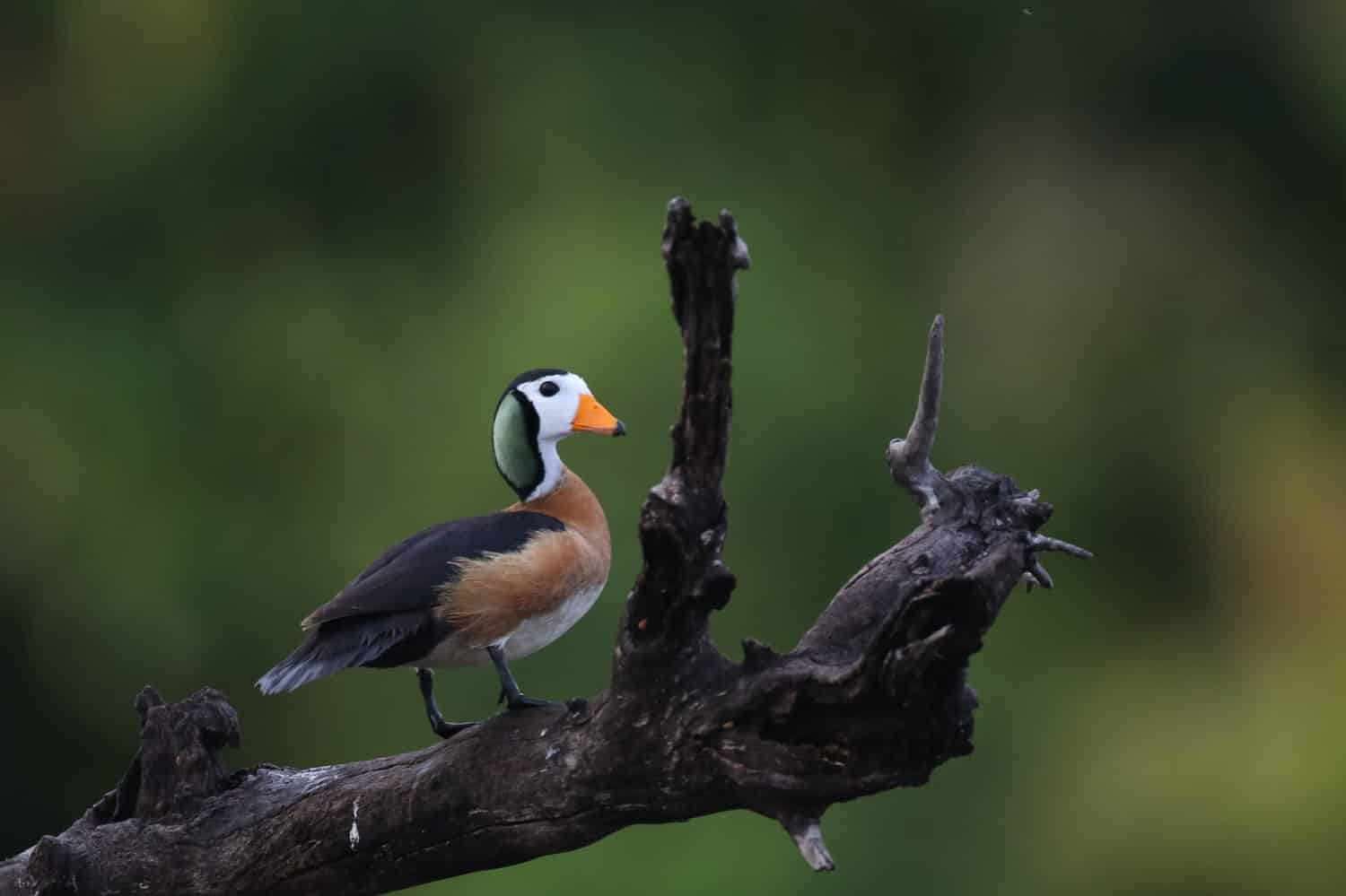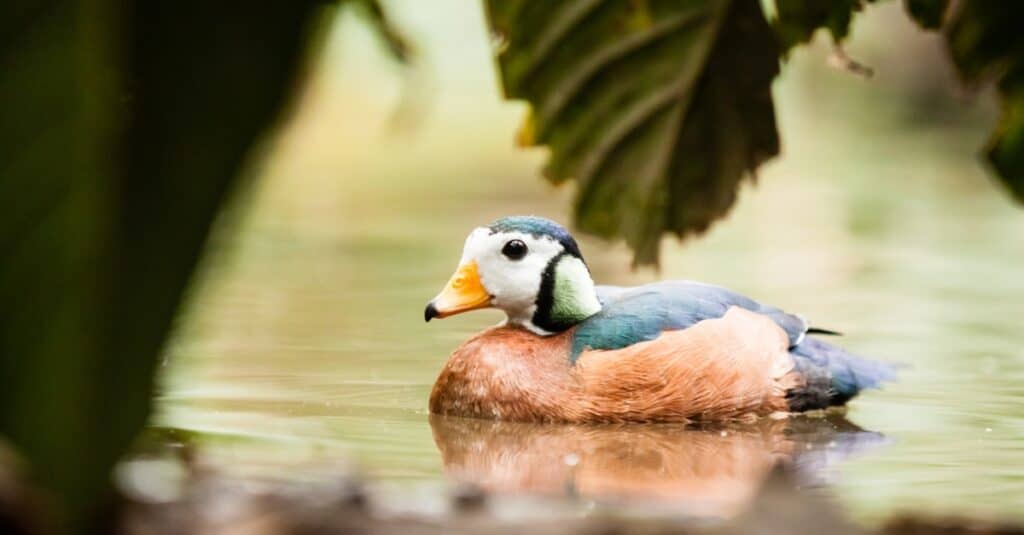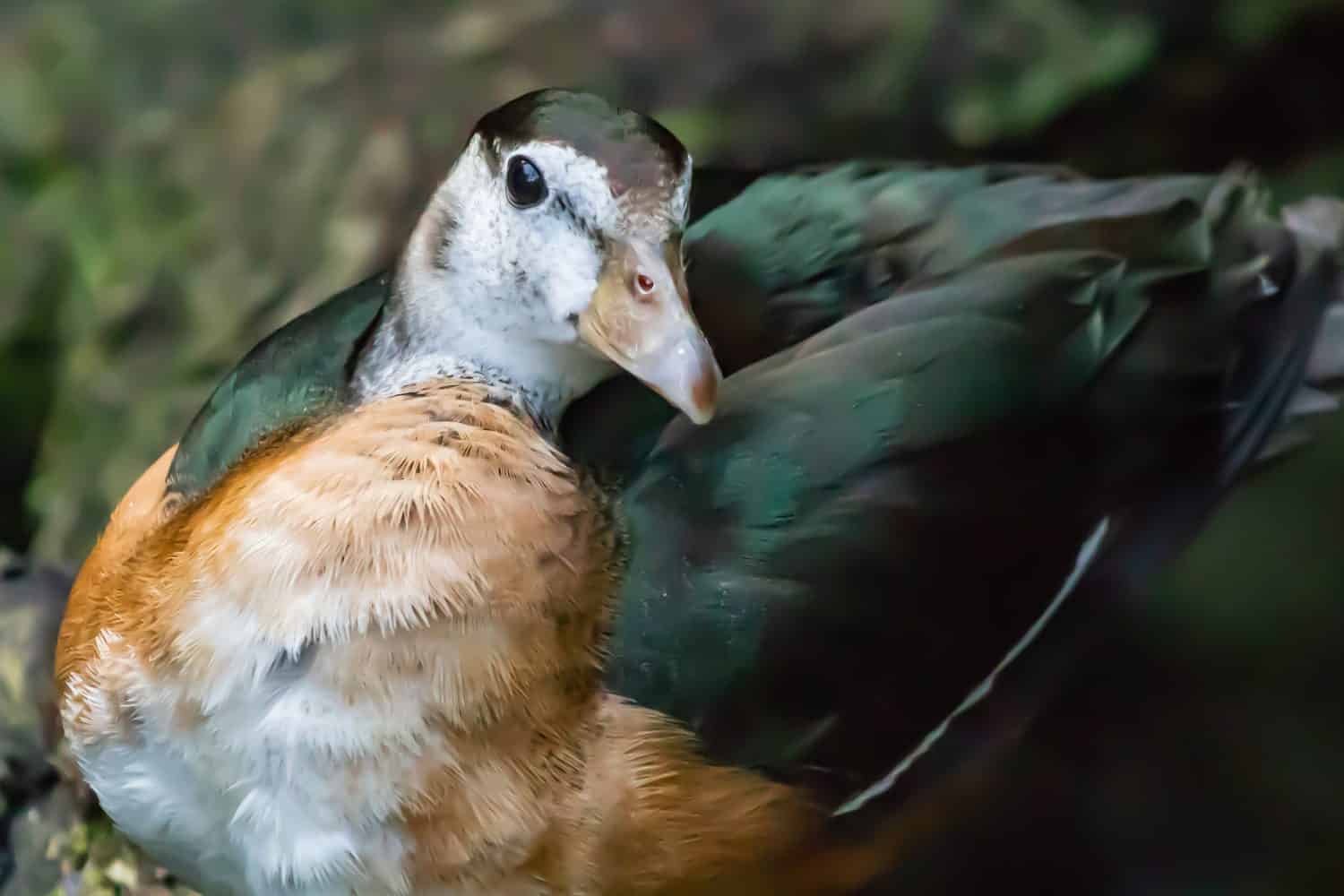The African Pygmy Goose is not a goose. Scientists classify it as a particular type of duck known as a perching duck. This type of duck has a very small bill, more like that of a goose than a typical duck. Reaching lengths of only about 12 inches, and weighing just 10 ounces, the African Pygmy Goose ranks as the smallest waterfowl in the world. This little duck also has a striking appearance with coloration reminiscent of the more elaborately patterned Wood Duck. Let’s get to know this amazing bird, where it lives, how it behaves, and much more.
Scientific Background of the Bird

The African Pygmy Goose is not a goose. It is a perching duck that nests primarily in trees.
©JMx Images/Shutterstock.com
The African Pygmy Goose, Nettapus auratus, belongs to the Anatidae family of birds. This family includes ducks, geese, and swans. The Nettapus genus includes the three pygmy goose species, of which the African Pygmy Goose is the smallest and most colorful. As the name suggests, this species lives in Africa. The other two species include the Cotton Pygmy Goose, Nettapus coromandelianus, which lives in Southeast Asia and Australasia, and the Green Pygmy Goose, Nettapus pulchellus, native to Australia and New Guinea.
Appearance

The African Pygmy Goose is a small duck with a bill that resembles that of a goose.
©iStock.com/Jarrycz
The African Pygmy Goose has a shape similar to small dabbling ducks such as the Green-winged Teal of North America. They have small bodies with rounded heads and short legs. These diminutive ducks average only about 12 inches in length. Males weigh slightly more than females, reaching around 10 ounces, while females average just over 9 ounces. Although these birds exhibit only slight sexual dimorphism with regard to size, they show more significant differences in plumage and other features.
Plumage
This species spends most of its time on the water, where its white belly stays concealed. Both males and females have reddish-brown or rufous colored feathers on their breasts and sides. They have dark brown to black tail feathers with lighter colored, speckled coverts. Females have dark brown to black backs, but the black plumage on the backs of males has a green metallic sheen. Both sexes have black wings with strong, white markings visible in flight.
Females have black and white splotchy feathers on their face and neck, with a dark brown crown with a slight green tinge that runs from their forehead to the back of their neck. Males have clean, white feathers on their face, with a bright green patch on the side of their head, rimmed in black. They also have an iridescent black crown on top of their head and down the back of their neck.
Other Features
The female African Pygmy Goose has a yellowish bill that appears smudged over with a dark, dusky wash. Their bill has a dark brown tip. The male of the species has a bright yellow bill with a dark brown to black tip. Both sexes have dark gray to black feet and dark eyes. Juveniles resemble females, but males develop mature coloration within about 10 months.
Where Does the African Pygmy Goose Live?
The African Pygmy Goose usually lives in wetlands such as swamps or marshes. They may also live around ponds, deltas, shallow lakes, and even slowly flowing rivers. They generally prefer to inland bodies of water but may also range in coastal areas. This species often lives near wooded areas, and frequently chooses locations with abundant water lilies. The range of the African Pygmy Goose includes most of sub-Saharan Africa, all the way to northern Namibia, Botswana, and northwestern South Africa. It also ranges over portions of Madagascar.
Where Does the African Pygmy Goose Nest?
The African Pygmy Goose, unlike most other ducks, nests primarily in tree cavities. It shares this trait with the Wood Duck of North America and the Mandarin Duck of east Asia. In addition to tree cavities, African Pygmy Geese will sometimes nest on the ground or in cavities in cliffs, banks or large termite mounds, in thatched roofs, or in thick reeds or other vegetation along the water.
Observers note that the male of each pair inspects multiple potential nesting locations before selecting a site. In captivity, these birds will use nest boxes, but they must have their pick from multiple boxes.
Once the female approves her mate’s chosen nest site, she builds the nest inside the cavity or box. Unlike most other ducks, that simply make a shallow scrape on the ground, African Pygmy Geese make deep scrapes and go on to build a nest out of grasses and other plant material. They may even line the nest with soft feathers before laying their eggs.
Reproduction

The African Pygmy Goose lays between 6 to 12 eggs per clutch.
©Wladimir Lopes/Shutterstock.com
African Pygmy Geese reach sexual maturity at about 2 years of age. They form monogamous pairs that may last for several years. The breeding season for this species varies, and it can take place from May through August. The timing depends largely on the rain in the area where the individual birds live.
Pairs produce between 6 to 12 eggs per clutch. The female assumes primary responsibility for incubating the eggs while the male watches over the nest. Incubation takes approximately 23 days, with individual eggs requiring between 21 and 28 days. The eggs all hatch synchronously, or at the same time, instead of one by one over a period of several days.
African Pygmy Goose hatchlings have mostly dark gray feathers on their upper parts with lighter, nearly white feathers below. They have dark eye masks and some dark mottled markings on their lighter sections, and a few light spots on their darker sections. This coloring helps protect them and provides some camouflage from potential predators. Snakes, such as the black mamba, have been known to devour nestlings, particularly in nests on dry land.
Behavior

This small perching duck may gather in small family groups on or near the water.
©Hladik99/Shutterstock.com
The African Pygmy Goose behaves a bit differently than many other ducks. They rarely form large flocks, but may congregate in small family groups. This species stays mainly in the water, and because these ducks live primarily in wetlands such as swamps and marshes, people rarely see them. People have described these birds as shy and secretive, noting that they tend to retreat to the safety of dense cover if approached.
Although listed as a resident throughout their range, the African Pygmy Goose does tend to move about throughout the year. It bases its movements on the availability of water, and thus any apparent migration tends to depend on the rain. These ducks may avoid areas that are either too dry or too flooded. They tend to prefer inland habitats, but will opt for coastal regions when the conditions make it necessary.
Diet
African Pygmy Geese are omnivores. They prefer to eat seeds and tender green parts of aquatic plants, especially water lilies. These birds most often nest near water sources with abundant water lilies in order to be close to the food they love best. Their bill is specially designed for tearing off pieces of aquatic plants. It has a sharp nail that they can use to rip away seeds and other pieces of plants as they swim through the water. They also eat a variety of aquatic insects and other arthropods, as well as fish.
Is the African Pygmy Goose Rare?
The IUCN Red List of Threatened Species categorizes the African Pygmy Goose as a species of least concern. The overall population is unknown, but it is thought to be decreasing. The species has a lifespan of 10 to 15 years. Habitat degradation, predation, and hunting, particularly in Madagascar, all present threats to the species. Conservation of wetland habitats across the bird’s range could help to preserve this species as well as many others.
The photo featured at the top of this post is © Bernard DUPONT from FRANCE / CC BY-SA 2.0 – License / Original
Thank you for reading! Have some feedback for us? Contact the AZ Animals editorial team.







